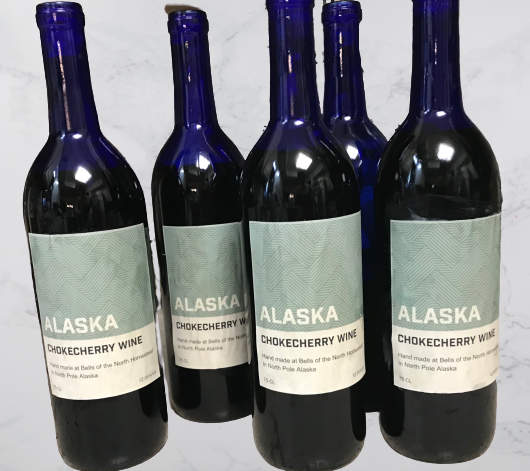Easy way to making Alaskan Chokecherry Wine at home
My goal, always, is to make something from our property. After all, if I make something from our property then doesn’t that mean my property has more value? I would think anyways. Ultimately it also boils down to the idea of “what if the grocery store went away, even for a little bit?” That sounds kind of crazy however lets go back five months and say that instead I wanted to install bidets in my house “just in case there is ever a TP shortage”. I betcha now it doesn’t sound so crazy does it??
We’re living in a world of such weirdness that I think we just have to adapt, overcome and rejoice that as humans, most of us can do just that.
So I have one VERY large chokecherry and then a couple of smaller chokecherry trees that I allow to exist on my property because the smaller ones serve as camouflage for more valuable edibles. (aka crabapple trees). In the past, I’ve made jelly out of the chokecherries. Last year I made lavender chokecherry jelly which, in my opinion, was the tastiest combo yet with chokecherries but I had decided also last year that I wanted to see what chokecherry wine would be like.
I do want to add right now, I actually do not drink anymore. I haven’t had a drink since 2011. Alcohol has been too corrosive in my life and in my family so I prefer to stay sober and happy over the alternative. Now if I buy alcohol it’s because I’m cooking with it. I might not drink anymore but I do enjoy what different spirits and wines add to food. After all, my ventures in gardening, in learning how to start at the basics of making things in the kitchen all is due to one key part of me. I’m a gastronome. Lover of amazing foods. Give me the odd, unique, unusual, and I’ll try it. At least once.
Time for the recipe
This recipe makes one gallon. One package of wine yeast is good for up to 5 gallons.
- 2 pounds chokecherries
- 1-gallon water
- 1 pound raisins
- 2 1/2 pounds of sugar
- 1 Campden tablet
- 1 teaspoon yeast nutrient
- 1/2 teaspoon acid blend
- 1/2 teaspoon pectic enzyme
- 1 package wine yeast (Montrachet preferred)
Pick fruit when ripe (black purple). Wash and remove stems, leaves, and bruised fruit.
- Mash cherries. Pits are too big to remove but be careful not to break them as they are bitter.
- Put the pulp in a nylon straining bag and squeeze out juice into primary fermenter.
- Put bag (tied closed) in primary fermenter with all ingredients EXCEPT YEAST.
- Wait 24 hours, then add yeast and cover. Specific gravity should be about 1.090-1.095.
- Check daily and push pulp bag down into the juice and squeeze it a little to help juice extraction.
- At specific gravity 1.030, take out pulp bag, squeeze out all juice and siphon into a glass fermenter.
- Leave in secondary fermenter for 3 weeks or until specific gravity is 1.000.
- Rack into clean carboy and age for at least 2 months before bottling.
We used to have a large glass carboy we used for these types of things however it broke about a year or two ago so now we use plastic buckets meant for brewing beer. I figure they work for wine too as long as I clean it really well. I used our bucket for the first stage and since it’s so chilly here in Autumn and Winter I placed the plastic container near the radiator. When I noticed the airlock was not bubbling as much I tested it and it was about 1.000 gravity. 
I have large bottles from a purchase long ago that held that cheap wine you get in those super huge bottles. I think those things hold a gallon? Or two. Regardless, I usually clean these out very well with bleach. Let them sit for about half an hour. Then rinse out thoroughly. I used the two bottles I have for racking off the wine for the second part which I always think of as “the resting phase”. I know that ultimately my goal during this phase is to let the sediment rest to the bottom of the bottle so I’ll get a clear, delicious end product and not something cloudy and bitter.
We have large tubing and a hand pump that allows us to move the wine or beer from one container to another without disturbing the liquid too much. When you get to the racking off stage you do not want to swish it around at all. Leave all that used yeast and other sediment at the bottom of your fermenting container. If anything, you can use it in other projects later on if you feel like saving it.
(I used the last dregs from the beer we made that on its own tasted HIDEOUS in beer bread and beer battered halibut. DELICIOUS!)
So, finally this past spring after my chokecherry wine had been resting since last autumn, I moved it to the final bottling stage. I even splurged some and got some very nice wine bottles that I’m sure we’ll reuse over and over because of course, I purchased a huge supply of corks and a hand held wine bottle cork installer that actually wasn’t that bad of a price considering I’ll be using it over and over.
How did it turn out?
This version of Chokecherry wine tastes somewhat similar to a burgundy but it has a fruity finish. I took a small sample, swished it around my mouth, and then spit it out much like a sommelier. It goes excellent with beef, bear most likely, or even moose or caribou if we could get one. I’ve already tried marinating steaks in it before grilling it and it really kicked it up a notch. Yum. 


